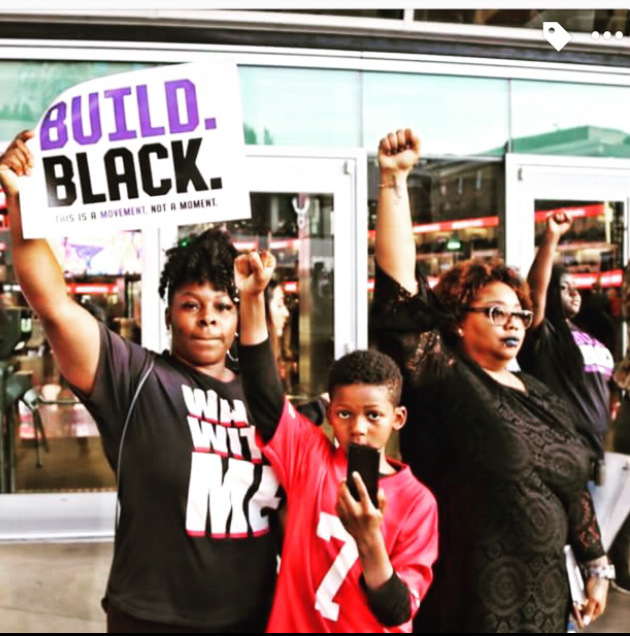 From left to right: Kyisha Smalling, Josiah Smalling and Nyati-Melissa Cleveland, standing together in solidarity in protest of racial injustice and the death of Stephon Clark in the city of Sacramento.
From left to right: Kyisha Smalling, Josiah Smalling and Nyati-Melissa Cleveland, standing together in solidarity in protest of racial injustice and the death of Stephon Clark in the city of Sacramento.Recently, the city of Sacramento has experienced the strength and power of the Black Lives Matter movement, as a result of the shooting death of Stephon Clark, an unarmed African American man who was killed by Sacramento police, last month.
Officers initially came in contact with Clark after being dispatched to the Meadowview neighborhood of Sacramento after a report came in of a man who was allegedly seen breaking into vehicles
After locating Clark with the help of a police helicopter, police cornered Clark in the backyard of his Grandmother’s home, where he was gunned down by two police officers in a matter of seconds.
Raw, full length, aerial helicopter and body camera footage released by police were made available on YouTube, further provided by ABC 10 that gives a detailed account of Clark’s final moments. (View here: https://youtu.be/FvCsU4w3Yec )
The footage shows the moment when officers spot Clark, the timestamp reads 04:26:24 and not even a second later the officer is seen drawing his gun as he engages in a foot pursuit that begins in a driveway of what is presumably the home of Clark’s Grandmother.
Seven seconds later, the officer can be heard shouting, “Hey! Show me your hands!!” Two officers are now engaged in the pursuit of Clark down the side yard of the home.
An officer instructs him to “stop,” twice in a row. It is assumed at this point that Clark entered the backyard, realized he can’t run any longer and is completely cornered, because both officers make their way around the side of home, ceasing pursuit, and engage in their alleged suspect.
After the two officers enter the backyard and get a split glimpse of Clark, the leading officer shouts, “Show me your hands! Gun!” as both proceed to duck for cover behind the side of the house with both of their weapons drawn.
Officers peek around the side of the house one more time. The leading officer shouts, “Show me your hands! Gun! Gun! Gun!” and instantaneously begins to fire his weapon several times before the second officer begins to engage in gunfire.
Unfortunately, the body cam footage does not show the actions or movements of Stephon Clark before any shots are fired. However, it did show a timestamp at the very moment that gunfire ceased, 04:26:54.
Just 30 seconds after initially spotting their alleged suspect, Stephon Clark’s body is lifeless and unresponsive to the continued demands of police to “Show us your hands!”
After the shooting, both officers begin to assess whether either of them had been shot. They perform a “tactical reload” and one officer says over his radio, “He’s still down, he’s not moving, we can’t see the gun.”
Shortly after, a police flashlight illuminates the backyard and we finally get a glimpse of Clark’s bodily state. He can be seen face down, motionless and fully unresponsive.
Moments later, the police Sergeant can be heard arriving on the scene and begins taking statement from both officers.The leading officer states, “He came up and then he kinda approached us with hands out and fell face first.”
The second officer tells his Sergeant, “He had somethin’ in his hands, it looked like a gun from our perspectives.”
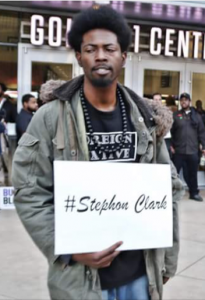
About five to six minutes after the first shots were fired, officers approach the motionless and unresponsive body of Stephon Clark.
They place him in handcuffs and roll his body from a facedown position onto his back, looking for the weapon that they claim Clark had been brandishing.
Emerging from under the right cheek of Clark’s face, a white cell phone comes into view. No weapon had been involved.
Following detainment and a safety clearance, officers then asked for a rescue mask and allowed medics to approach Clark’s body for life saving efforts.
Shortly after, all officers then muted the mics to their body cameras.
Clark’s deadly and questionable encounter with police has raised many questions and further sparked its own hashtag; garnered national media attention; ignited its own fiery movement for change; lead to the involvement of the Sacramento Kings and the NBA, and it has even inspired Yuba College students to get involved.
Yuba College Students were front and center to show their support and get involved in the protests for Stephon Clark. Nyati-MeLissa Cleveland, who has been a Yuba College student for three years was one of those students. Cleveland said, “Some of us went to council meetings, some of us marched, and some of us went to the protests. It was beautiful.”
As students participated in their own way, Cleveland discussed why she felt inspired to get involved. She shared her experience growing up in the Bay Area in a disenfranchised neighborhood, similar to Clark.
She recalled all of the times she witnessed police officers enter her neighborhood and start whipping people with belts; how they would strip men of all of their clothes, line them up on a wall and do cavity checks in front of the entire community, on the street.
Cleveland shared an experience of one of her long time friends, “He was frisked by police, they suspected he had drugs, but he didn’t have any drugs on him. They told him “Well, we want to make sure you don’t sale or do any drugs,” so they drove him out to the middle of nowhere, all alone and made him walk all the way home.”
When explaining how these problems came to be, Cleveland says, “There has always been a discourse between the law and black people,” and it can be dated all the way back to slavery.
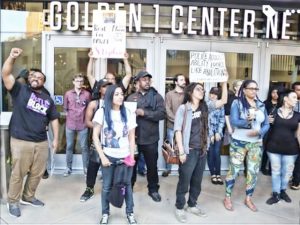
Cleveland further explained, “The relationship started to improve slowly over time and it wasn’t until the Nixon Campaign that the situation became more complicated. Nixon’s Campaign and the war on drugs was an effort to demonize hippies and black people. Nixon’s adviser, John Ehrlichman, admitted later that he had lied about the war, because hippies were against the war and the black community was getting larger and their relationship with police was improving and they didn’t want that. In the end, Ehrlichman admitted that they couldn’t make it illegal to hate hippies or illegal to hate black people, so they connected marijuana to hippies and heroin to black people to vilify both.”
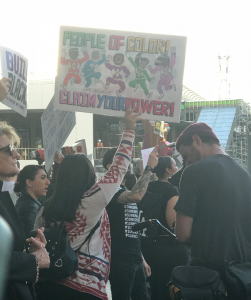
History gives us a solid look at the cold, hard truth at how the relationship between law enforcement and the African American community has become strained and bitter.
Although, we have made strides on improvement towards racial justice, as Cleveland points out, “It’s not just a “them” thing and it’s not just an “us” thing, we all play a residual part in it, somewhere along the line.”
Cleveland is a young African American woman, who personally knows the struggle of what it’s like to grow up in a disenfranchised neighborhood. She witnessed and experienced her own injustices and felt her own pain and grief over the injustices that the African American community still face. When talking of the protests and what it was like to take part in a movement that hits so close to home, Cleveland spoke of beauty, excitement, culture and solidarity among the people who participated.
She says of the experience, “There weren’t just black people out there, there were white people out there. There were brown people out there. There were old people out there. There was a female, white, catholic priest out there and that’s what made it beautiful, that it’s not just a one race problem, because if it happens to one race, it will happen to another race and another race and then you look up and its happening to you.”
Cleveland told the touching story that took place during a protest at the Golden 1 stadium. The stadium serves as the home to the Sacramento Kings and had to close its doors for two out of three games due to the Stephon Clark protests.
During this particular protest, Cleveland says that there were two, clearly divisible sides between protesters and those who were only there to watch the game. For those who wanted to see the game, they started to ask questions out of frustration for the inability to see the game due to their protests.
Cleveland says, “One man, from the other side had started talking to a female protester on our side and asked questions like, ‘Why are you doing this? What do you hope to accomplish by stopping us from seeing the game? Ya know, we have season tickets for these games and they were very expensive!”
Cleveland explains that this was the mindset of most people from the other side and the view that season tickets to a basketball game are worth more than a life was precisely why they were there.
“They didn’t understand our purpose, but that was our purpose, to stand there, answer their questions, raise awareness, and to inform the public on what is happening around them. We peacefully addressed their questions and in this case, the female protester responded to that man and had said, “You mean to tell me sir, that season ticket are more valuable than a life?” She pointed to his children and then asked “What if it was your child’s life?”
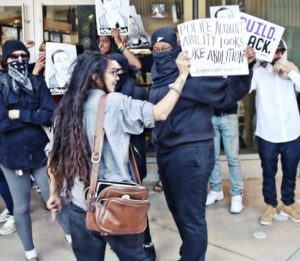
Cleveland says that she stood there to watch this man’s response to such a hard hitting question. She watched the man think about it. She watched him take a good long, hard look at the faces of his children. She continued, “He really thought about it and unfortunately, I wasn’t close enough to be able to hear his quiet response to that woman, but the next thing I know, after he looked at his children and thought about it, was that man and his family coming over to our side and joining us.” Cleveland explained the revelation she had in that moment, of the ignorance that still exists after all this time. “ People just don’t have knowledge on the true nature of what has happened in the past and what is happening now.” She says, “We were there doing something. We were sharing that knowledge and raising awareness. It was beautiful.”
Cleveland isn’t limiting her activism to just protests. Moving forward, she would like to create a panel with her fellow Yuba College colleagues in hopes of making a difference.
The panel would become a place where those who wish to run for office in Yuba and Sutter counties can speak directly to the people, in an effort to learn the real identities of the people that they wish to serve. She hopes that this will provide some level of accountability for the actions of our leadership and help measure how much progress they make in their communities for effectiveness.
“We don’t always know how to talk effectively to different types of people, because there are different neighborhoods, cultures, backgrounds, religions, different ways of life and with proper communication, police officers can have a better understanding through leadership, how there is so much more to people than what you see on the outside. If they have a better understanding of the people within each community, that would help build a better working relationship.”
While Cleveland works to create this panel, she plans to continue raising awareness on the racial injustices that the African American community still faces. Taking a stand is what Cleveland does, who she is, and what she will continue to do until these types of injustices stop happening. She says, “I believe that people who speak and don’t do are just blowing hot air. I wanted to do something and part of me taking action was going to the protests. You can only make a difference if you’re present.”
Edited for accuracy: July 16, 2018
Comment Policy: Comments are welcomed and encouraged. However, the editorial board reserves the right to edit or delete, without notice, any comments submitted to the blog. For more details, see our full Comment Policy.